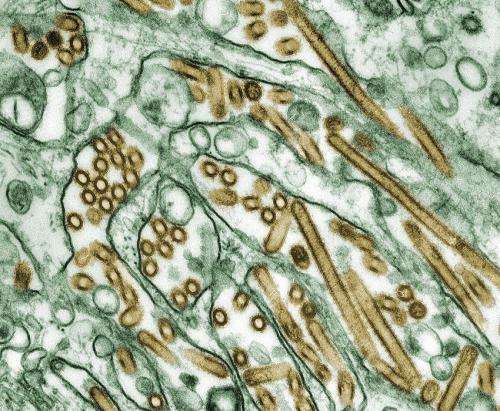June 24, 2014 report
Researchers find putting birds of different life-spans together can promote emergence of dangerous influenza strains

(Phys.org) —A trio of researchers in the U.K. has found that housing birds of different life-spans together can contribute to the emergence of dangerous flu strains. In their paper published in Proceedings of the National Academy of Sciences, Paul Wikramaratna, Oliver Pybus and Sunetra Gupta of Oxford University describe how they developed a model that allows for studying the evolution of flu viruses in domestic and wild bird species with various life-spans and what they found when running it.
Most research involving the spread of avian flu, the researchers note, is focused on the ability of such viruses to mutate and spread to other possible hosts. In their study, the trio took the opposite approach, looking at the immunity capabilities of birds of different species to see how they respond to such viruses. To gain a better understanding of flu transmission from the perspective of the birds, the team built a model (combining three properties—pathogenicity, antigenicity, and transmissibility) that was able to use data from prior studies on flu prevalence with birds in Europe, focusing most specifically on the competition that exists between strains that are considered more or less pathogenic.
The result was a model that could be used to show the degree to which different species of birds were able le to ward off different flu pathogens. The researchers found that strains considered to be highly pathogenic were more likely to emerge in bird species that didn't live very long compared to long-lived varieties. This they attributed to higher turnover in the population. The model was also able to show that contact between short-lived species and long-lived species could promote the emergence of highly pathogenic flu variants. In real-world terms, the researchers suggest, this means that housing short-lived domestic birds, such as ducks near to areas where long-lived wild birds lived could promote the emergence of dangerous flue variants, which would allow for the spread of highly pathogenic avian influenza variants by the wild birds. They suggest that changes in farming practices (where birds are now kept in open enclosures rather than closed) over the past 20 years have likely contributed to the increase in virulent outbreaks that have been observed in recent years.
More information: Contact between bird species of different lifespans can promote the emergence of highly pathogenic avian influenza strains, Paul S. Wikramaratna, PNAS, DOI: 10.1073/pnas.1401849111
Abstract
Outbreaks of highly pathogenic strains of avian influenza viruses (AIVs) cause considerable economic losses to the poultry industry and also pose a threat to human life. The possibility that one of these strains will evolve to become transmissible between humans, sparking a major influenza pandemic, is a matter of great concern. Most studies so far have focused on assessing these odds from the perspective of the intrinsic mutability of AIV rather than the ecological constraints to invasion faced by the virus population. Here we present an alternative multihost model for the evolution of AIV in which the mode and tempo of mutation play a limited role, with the emergence of strains being determined instead principally by the prevailing profile of population-level immunity. We show that (i) many of the observed differences in influenza virus dynamics among species can be captured by our model by simply varying host lifespan and (ii) increased contact between species of different lifespans can promote the emergence of potentially more virulent strains that were hitherto suppressed in one of the species.
Journal information: Proceedings of the National Academy of Sciences
© 2014 Phys.org
















